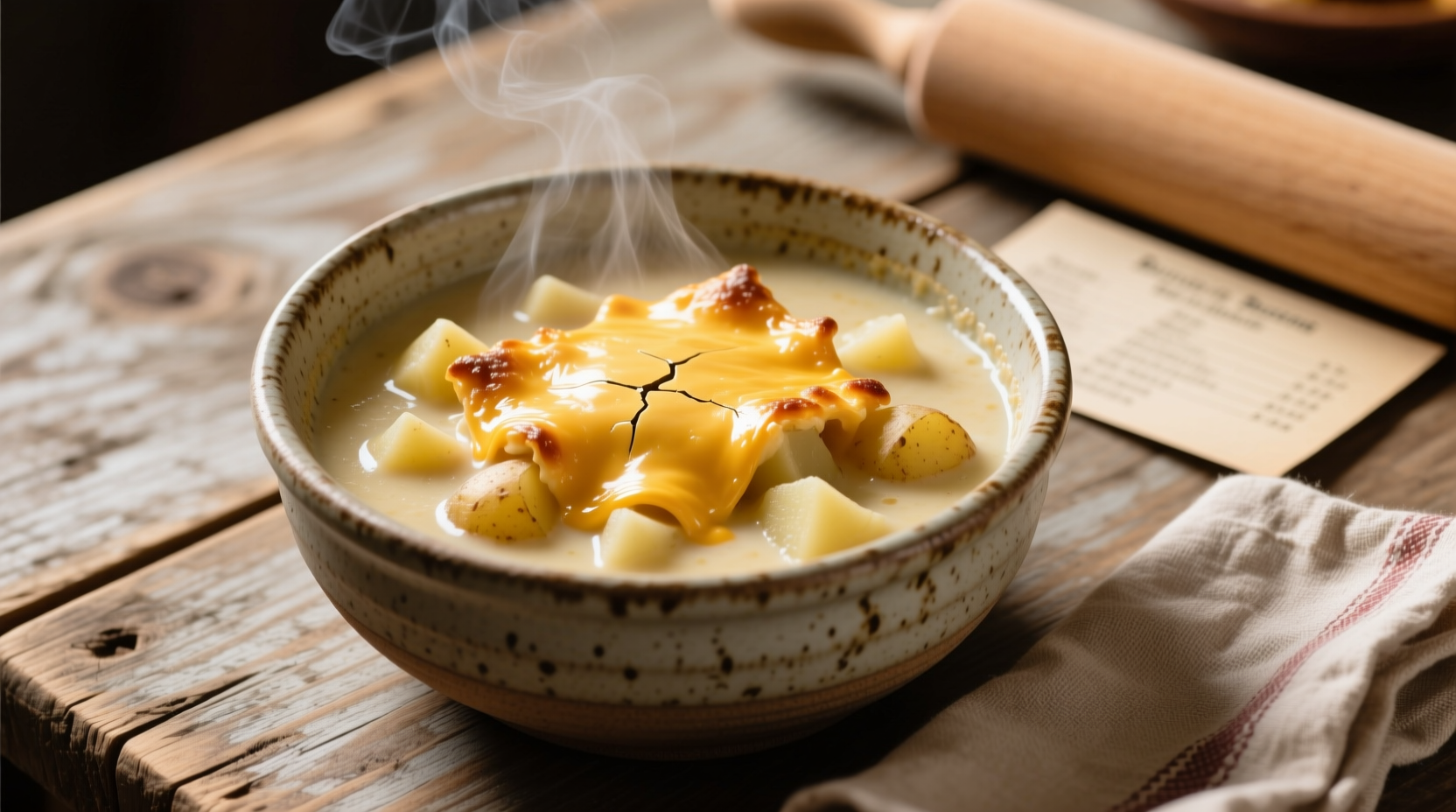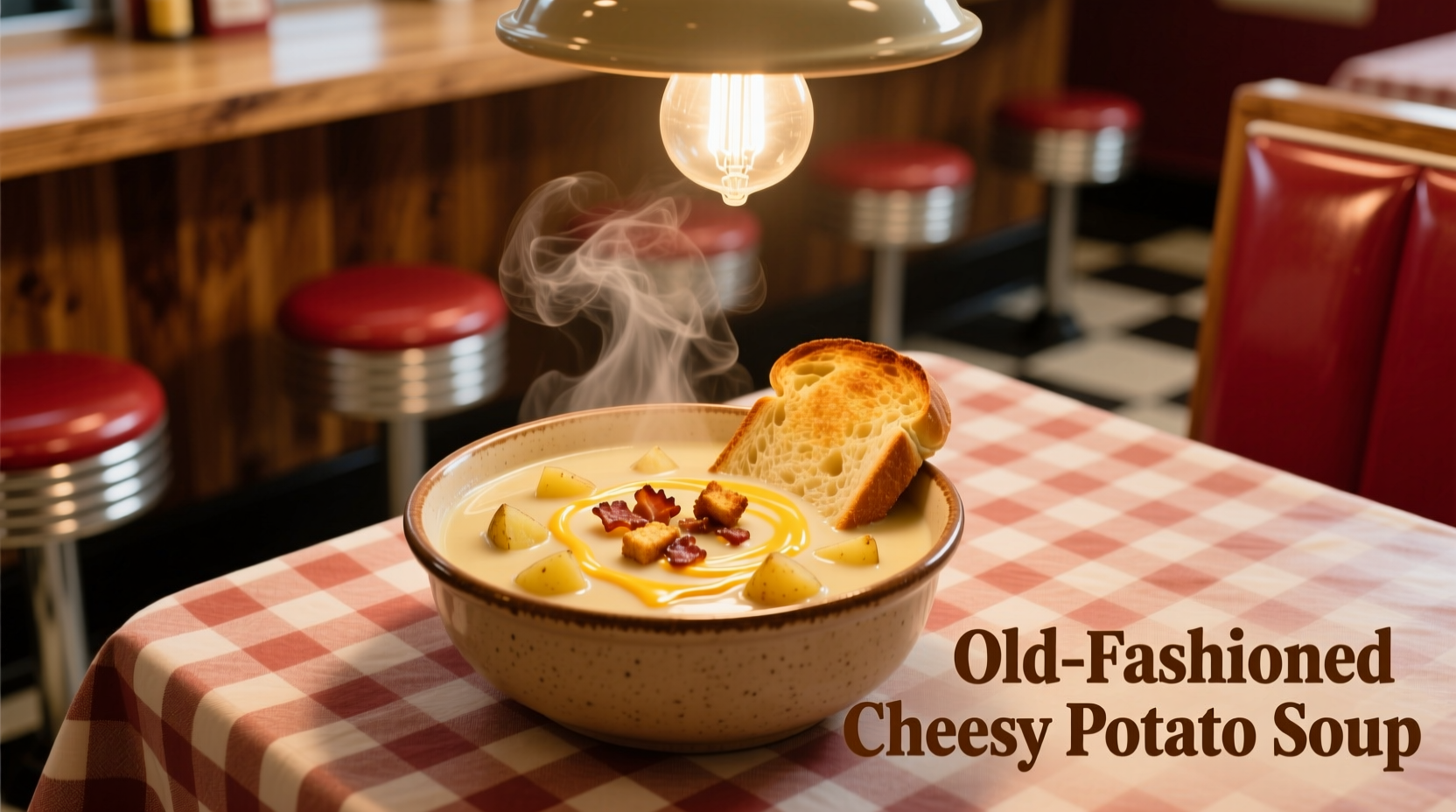The Timeless Appeal of Traditional Cheesy Potato Soup
There's something profoundly comforting about a bowl of old fashioned cheesy potato soup that modern shortcuts can't replicate. Unlike today's quick versions using canned soup or powdered mixes, the authentic recipe builds flavor from fundamental ingredients through careful technique. This isn't just food—it's edible history that connects us to generations of home cooks who perfected this humble dish through trial and error.
What Makes Potato Soup "Old Fashioned"?
The distinction between authentic old fashioned cheesy potato soup and contemporary versions lies in preparation method and ingredient quality. Traditional recipes avoid convenience products entirely, instead developing flavor through proper potato cooking, roux-based thickening, and careful cheese incorporation.
| Traditional Approach | Modern Shortcut Approach |
|---|---|
| Hand-cut russet potatoes cooked from raw | Canned potatoes or instant flakes |
| Roux made with butter and flour for thickening | Cream of mushroom or celery soup base |
| Real sharp cheddar freshly grated | Pre-shredded cheese with anti-caking agents |
| Homemade chicken or vegetable stock | Water or bouillon cubes |
| Finished with cream or whole milk | Non-dairy creamer or evaporated milk |
Historical Evolution of Potato Soup
Potatoes arrived in Europe from South America in the 16th century, but didn't become soup staples until the 18th century when Irish and German immigrants brought their potato-based culinary traditions to America. According to the Library of Congress, potato cultivation expanded dramatically during the Irish Potato Famine era, making potatoes an affordable staple for working-class families.
Early potato soups were simple peasant fare—boiled potatoes with whatever vegetables or scraps of meat were available. The addition of cheese came later, influenced by Swiss and Dutch dairy traditions. By the early 20th century, as documented in the Michigan State University Cookbook Collection, creamy potato soup recipes began appearing in American community cookbooks, though the "cheesy" variation didn't become widespread until post-WWII when cheddar cheese production increased.

Essential Ingredients for Authentic Flavor
The magic of genuine old fashioned cheesy potato soup comes from ingredient quality and proper technique. Here's what you need:
Potatoes
Russet potatoes are essential—they have the right starch content to create that signature creamy texture when properly cooked. Waxy potatoes like reds or Yukon Golds won't break down sufficiently to thicken the soup naturally.
Cheese
Sharp cheddar provides the classic flavor profile, but the quality matters. Avoid pre-shredded cheese which contains cellulose that prevents proper melting. Freshly grated cheese from a block melts smoothly and delivers superior flavor.
Thickening Agent
A simple roux (equal parts butter and flour cooked together) creates the proper base. This traditional thickening method gives better texture and flavor than cornstarch or canned soup alternatives.
Step-by-Step Preparation Guide
Proper Potato Cooking Technique
The foundation of great potato soup is perfectly cooked potatoes. Peel and dice 2 pounds of russet potatoes into 1/2-inch cubes. Place in cold salted water, bring to a gentle simmer (not boil), and cook until just tender—about 15 minutes. Overcooking creates gluey texture; undercooking leaves chunks that won't blend smoothly.
Building Flavor Layers
- Melt 3 tablespoons butter in a heavy pot
- Add 1 diced onion and cook until translucent (5-7 minutes)
- Stir in 3 tablespoons flour to create roux, cooking 2 minutes
- Gradually whisk in 4 cups warm chicken or vegetable stock
- Add cooked potatoes with their cooking liquid
- Simmer 10 minutes to meld flavors
Incorporating Cheese Perfectly
This is where most recipes fail. Remove soup from heat before adding cheese. Gradually stir in 2 cups freshly grated sharp cheddar. Adding cheese to boiling liquid causes separation. For extra creaminess, stir in 1/2 cup heavy cream at the end.
Avoiding Common Pitfalls
Even experienced cooks make these mistakes with old fashioned cheesy potato soup:
Cheese Separation
Caused by adding cheese to boiling liquid or using pre-shredded cheese with anti-caking agents. Solution: Remove from heat before adding freshly grated cheese.
Gluey Texture
Results from overcooking potatoes or using a blender instead of mashing by hand. Solution: Simmer potatoes gently and use a potato masher for desired consistency.
Bland Flavor
Often from insufficient seasoning or using low-quality ingredients. Solution: Season potatoes in cooking water, use homemade stock, and finish with fresh herbs.
Serving and Storage Tips
Traditional old fashioned cheesy potato soup tastes best when served immediately, but properly stored leftovers maintain quality. Cool completely before refrigerating in airtight containers for up to 3 days. When reheating, add a splash of milk or stock to restore creamy consistency—cheese-based soups thicken when chilled.
For freezing, omit the dairy and cheese before freezing. Add these fresh when reheating for best texture. Properly stored, the base soup freezes well for up to 3 months.
Variations While Preserving Authenticity
You can personalize your old fashioned cheesy potato soup while maintaining its traditional character:
Bacon Enhancement
Cook 4-6 slices of thick-cut bacon first, then use the rendered fat for your roux. Crumble cooked bacon as garnish. This adds smoky depth without compromising the soup's fundamental character.
Herb Infusion
Add a sprig of fresh thyme or rosemary during simmering, removing before serving. Dried herbs work too, but use half the amount as fresh.
Dairy Alternatives
For lactose-intolerant guests, substitute full-fat coconut milk for dairy cream. Use lactose-free cheddar cheese for the cheesy component. Note that these substitutions alter the traditional flavor profile.











 浙公网安备
33010002000092号
浙公网安备
33010002000092号 浙B2-20120091-4
浙B2-20120091-4